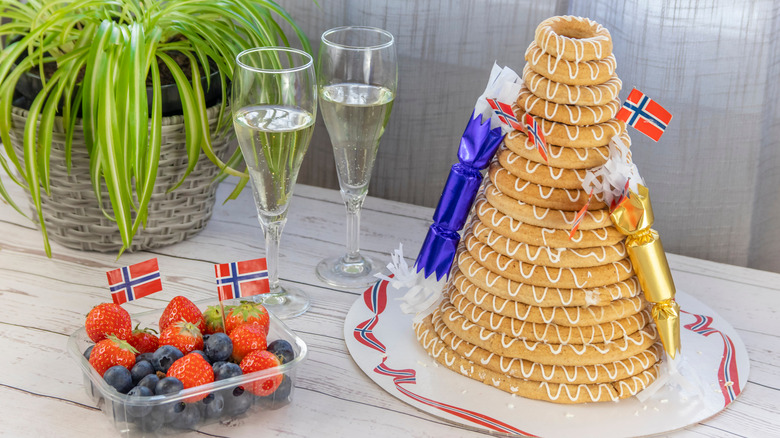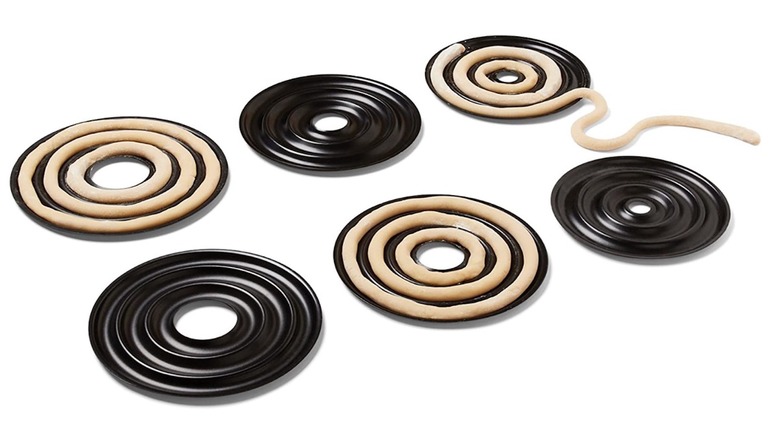The Norwegian Tower Cake Made To Hide A Bottle Of Champagne Inside
Many cultures have cuisine and cake recipes that celebrate memorable occasions. In the U.S., layer cakes feature alternating layers of cake and icing. The Dobosh torte is made from sponge cake layered with chocolate frosting in Hungary. The moon cake in China is filled with sweet paste and symbolizes the lunar cycle. And Germans are famous for their strudel, and in Austria, the Sacher torte is the sweet choice.
In Norway and other Scandinavian countries, the kransekake reigns supreme. Kransekake, according to Food Network, means "wreath cake," but it's actually made of stacked rings of decreasing size, which reach a towering height. The rings are made from a cross between meringue and marzipan, resulting in a chewy mixture that is crisp outside. It's typically held together and decorated with zigzags of white royal icing and can be garnished with flags, flowers, or other décor and can hide something special inside.
History of kransekake
While most Scandinavian countries make this cake, it's originally attributed to the Danes and Norwegians, according to Outside Oslo. It's proudly brought out at different celebrations in each country, and in Finland, a bottle of champagne is hidden inside. Traditionally, it has 18 rings, but it can be made smaller.
The history of kransekake begins in 1806 in Copenhagen, Denmark, according to Vogue Scandinavia, when it was published in a cookbook by chef Hans Heinrich Petersen. Marzipan, one of the critical components in this cake, was very expensive since almonds were grown in Spain and Italy, and sugar came from sugar canes, which both had to be imported. Both ingredients were considered the provenance of the rich and elite. In 1872, a sugar factory using sugar beets, which grew in the frozen north, was established in Denmark, per JSTOR. Then almonds were imported from Germany, according to Trading Economics, making the ingredients for kransekake more affordable and available.
Also according to Vogue Scandinavia, a recipe for kransekake appeared in Norwegian cookbooks in the 19th century. So although the Danes allegedly invented it, it's mostly known as a Norwegian delicacy.
How kransekake is made
You can make kransekake at home, although most prefer to buy it from Scandinavian bakeries. You can also order it online from Taste of Scandinavia and other bakeries. But if you prefer to bake it yourself, Martha Stewart has a recipe. You can form the soft dough into rings freehand, but you'll get a better-looking cake if you buy ring molds specially made for this dessert; you can find them on Amazon.
To make the dough, you start by processing sliced almonds to form a fine flour. That flour is mixed with confectioners' sugar, salt, and unbeaten egg whites until it forms a dough similar to cookie dough. The dough is chilled overnight to make it easier to handle.
Then you grease the molds with unsalted butter and roll the dough into thin ropes. Fit the dough into the molds, join the ends, then bake. The rings are completely cooled in the molds. Make royal icing, then begin stacking the rings, using a bit of icing to hold them in place. Once that's finished, you can go wild with decorating; use flags, flowers, little toys, and favors, and, if you like, hide a bottle of champagne in the center.


